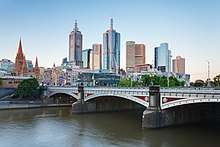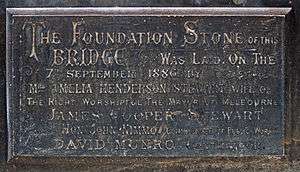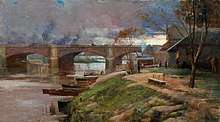Princes Bridge
| Princes Bridge | |
|---|---|
 | |
| Coordinates | 37°49′09″S 144°58′06″E / 37.8192°S 144.9682°ECoordinates: 37°49′09″S 144°58′06″E / 37.8192°S 144.9682°E |
| Carries | Trams, road vehicles, pedestrians, cyclists |
| Crosses | Yarra River |
| Locale | Melbourne, Australia |
| Official name | Princes Bridge |
| Characteristics | |
| Design | Arch bridge |
| Total length | 120 metres (400 ft) |
| Width | 30 metres (99 ft) |
| History | |
| Designer | John Grainger |
| Construction start | 1886 |
| Opened | October 4, 1888[1][2][3] |
Princes Bridge, originally Prince's Bridge,[4] is an important bridge in central Melbourne, Australia that spans the Yarra River. It is built on the site of one of the oldest river crossings in Australia. The bridge connects Swanston Street on the north bank of the Yarra River to St Kilda Road on the south bank, and carries road, tram and pedestrian traffic. The present bridge was built in 1888 and is listed on the Victorian Heritage Register.[5]
Because of its position, Princes Bridge is often a focal point for celebratory events in Melbourne such as the Moomba Festival, New Year's Eve and many celebrations taking place on the Yarra River where it flows through the city.
History



When the first European settlers settled in Melbourne in 1835 there was no permanent crossing point of the Yarra River. Over time various punt and ferry operators set up business to ferry people and other traffic across the river. The colonial government in Sydney was unreliable in providing funds for the construction of a bridge, resulting in most of Melbourne’s early infrastructure being provided by private enterprise. On 22 April 1840, a private company was formed to construct a bridge across the Yarra. Traders in Elizabeth Street vied with those in Swanston Street to have the through traffic that would be generated by a bridge. On the south bank of the river, St Kilda Road was still a dirt track.
Lieutenant-Governor Charles La Trobe favoured an Elizabeth Street crossing, but despite such official pressure the private company favoured the construction conditions at Swanston Street, which had become regarded as the growing town's main street. It was on that street in 1840 that they opened their wooden toll bridge. In 1844, a wooden trestle bridge was built across the river, and was a toll bridge.[6]
The foundation stone for a new bridge was laid in 1846[4] and the bridge was opened in 1851. The bridge was a single span 150 ft (46 m) bluestone and granite arch bridge, with a rise of only 24 ft (7 m).[7] It was at the time, one of the longest, flattest stone arch bridges in the world. Built with government funds, the bridge was designed by David Lennox,[6] and built by James Linacre.[8] It was opened on 15 November without tolls. It was known as Lennox’s Bridge.[9].
Within a year of Lennox Bridge's opening, gold was discovered in country Victoria and Melbourne saw a massive increase in population. In addition to the increase in traffic crossing the bridge, there was also a need to handle increased shipping traffic on the Yarra River and the river was widened to cope with this. By that time the Yarra River had been heavily modified both upstream and downstream and the major floods of the early years were becoming less common. The new bridge was designed by John Grainger (1855–1917),[10]:p.3 the father of the Australian composer Percy Grainger, and built by David Munro using ironwork fabricated by Langlands foundry in Melbourne. Munro was also responsible for the construction of Queens Bridge (Melbourne) (opened 1889) and the nearby Sandridge Bridge (opened 1888). Each stone of the old bridge was lettered and numbered and neatly stacked with the intention of re-erection at another location. This never eventuated because in November 1885, the contract for the construction of the new bridge was awarded to David Munroe & Co. for £136,998 9s.9d. which included the use of the materials from the old arched bridge. The foundation stone of the new bridge was laid on the 7th September 1886, and a memorial stone with a suitable inscription had been built in over its position in the west end of the south abutment. The new bridge was opened on 4 October 1888,[1] in time for the second International Exhibition to be held in Melbourne. As with many historic Melburnian buildings and bridges, the bridge is built on solid bluestone and concrete bulwarks with plenty of cast iron. The abutments, piers and wing walls are built of solid bluestone.
The bridge was named Prince's Bridge, after Edward, Prince of Wales (later King Edward VII).[11] In 1924,the bridge was reinforced to take the weight of the electric trams which were soon to replace the previous cable trams along St Kilda Road and the side-streets. The name of the bridge is now rendered as Princes Bridge, in line with the policy that possessive apostrophes are not used in place names.[12]
Princes Bridge was also the name of a railway station located on the northern side of the river, to the east of the bridge, on the current site of Federation Square. It was linked to Flinders Street station by the railway tracks that run underneath the northern approach to the bridge.
Until about June 2013 there were two vehicle lanes, a tram lane and a bicycle lane across the bridge in each direction. At that time the bicycle lane was widened and the number of vehicle lanes was reduced to a single lane in each direction.[13]
Traffic
Pedestrians account for the majority of traffic over the bridge, but other forms of traffic include motor vehicles, trams, buses and bicycles, as well as an occasional tourist-orientated horse-drawn carriage. The destination of pedestrian traffic is two way, with many commuters parking at the Arts Centre and going to work in the CBD, as well as visitors to the Melbourne Arts Precinct on the Southbank side.
Design
Princes Bridge is 30 metres (99 ft) wide and 120 metres (400 ft) long, with Harcourt granite squat half columns resting on the bluestone piers that support the three iron girder arch spans. The coat of arms on the bridge belong to the municipal councils who contributed towards the cost of construction. Other design features include an elaborate balustrade along the top of the bridge, and lamp standards crowning each pier.[11]
The bridge design bears a close resemblance to the earlier Blackfriars Bridge over the River Thames in London, which was completed in 1869. Princes Bridge is wider, 30 metres compared with 26 metres, but with 3 spans of 33 metres and an overall length of 131 metres it is much shorter that Blackfriars Bridge's 5 spans with its central span of 61 metres. Both are excellent surviving examples of Arch Bridge design in the late 19th century.
The bridge underwent a restoration before the 2006 Commonwealth Games.
Gallery
- Princes Bridge and the Melbourne CBD from the Yarra River
_underside.jpg) Underside of the iron girder arches
Underside of the iron girder arches A lamp on the bridge
A lamp on the bridge Southbank with Princes Bridge in the foreground
Southbank with Princes Bridge in the foreground
See also
References
- 1 2 "A Bridge of Size". The Australian Star (263). New South Wales, Australia. 4 October 1888. p. 5 (THIRD EDITION). Retrieved 22 April 2017 – via National Library of Australia. , ...Melbourne This Day. — The new Princes Bridge was opened to.day, without- any public ceremony beyond the Commissioner for Public Works entertaining a number of gentlemen at luncheon at the Town Hall...
- ↑ "THE NEW PRINCE'S-BRIDGE". The Argus (Melbourne) (13, 193). Victoria, Australia. 3 October 1888. p. 12. Retrieved 22 April 2017 – via National Library of Australia.
- ↑ "THE NEW PRINCES-BRIDGE". The Age (10, 490). Victoria, Australia. 5 October 1888. p. 11. Retrieved 22 April 2017 – via National Library of Australia.
- 1 2 "PORT PHILLIP.:LAYING THE FOUNDATION STONES OF THE NEW BRIDGE AND HOSPITAL, AT MELBOURNE". The Sydney Morning Herald. XXI, (2773). New South Wales, Australia. 1 April 1846. p. 3. Retrieved 22 April 2017 – via National Library of Australia. , ...he wished that it might be distinguished by the name of "Prince's Bridge," in honour of the Prince of Wales, whom he hoped would yet be the Sovereign of their colonies...
- ↑ "Princes Bridge, Victorian Heritage Register (VHR) Number H1447, Heritage Overlay HO790". Victorian Heritage Database. Heritage Victoria.
- 1 2 "Some significant dates in the History of the City of Melbourne Archived 10 August 2008 at the Wayback Machine.", City of Melbourne Archived 24 February 2011 at the Wayback Machine.
- ↑ Victorian Government Gazette, 1850, Vol 49, Wednesday 20 Nov 1850, Page 985. "Return of Public Works" David Lennox.
- ↑ http://www.swvic.org/sandford/hughes_j.htm
- ↑ "Streets and roads - City of Melbourne". melbourne.vic.gov.au. Archived from the original on 2 February 2015. Retrieved 21 March 2015.
- ↑ Tibbits, G. R. and Beauchamp, D. John Harry Grainger: Engineer and Architect Archived 12 February 2013 at the Wayback Machine. at 3rd Australasian Engineering Heritage Conference 2009. Retrieved 2013-01-15.
- 1 2 "Princes Bridge (listing RNE5202)". Australia Heritage Places Inventory. Department of Sustainability, Environment, Water, Population and Communities. Retrieved 2008-07-08.
- ↑ "Home Page". Victorian Towns and Localities. Ancestry. Archived from the original on 2 October 2017. Retrieved 2 October 2017.
- ↑ New bicycle lane on Princes Bridge opens with minimal traffic mess Archived 20 June 2013 at the Wayback Machine., By Jessica Evans, 19 June 2013, HeraldSun
External links
| Wikimedia Commons has media related to Princes Bridge. |
- Federation Square web site History of the Federation Square site, including a PDF file documenting some of the history of Princes Bridge.
- Panoramic virtual tour from Princes Bridge